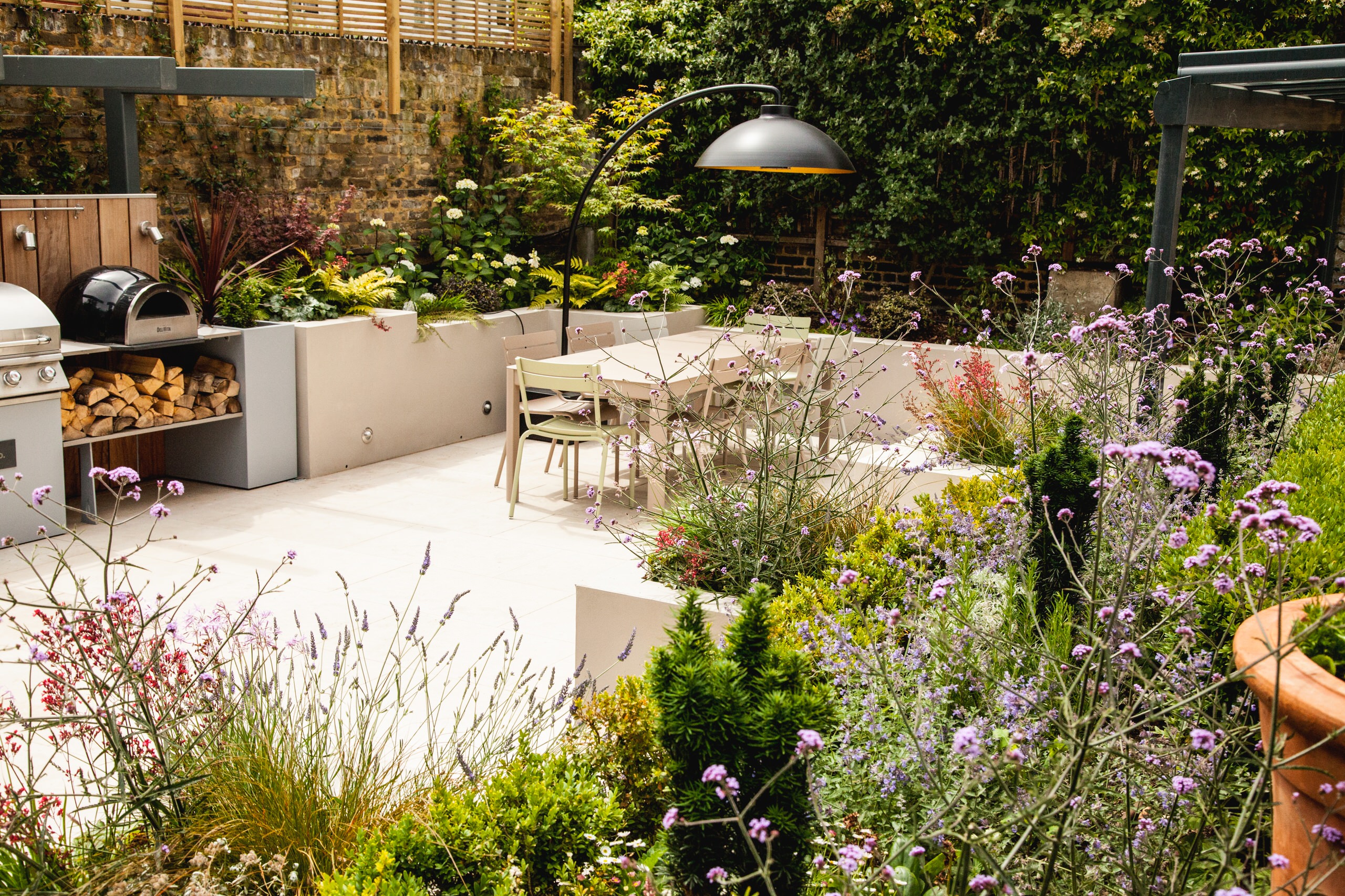 Yard at a Glance
Yard at a GlanceWho lives here: A couple and their two teenage children
Location: West London
Size: 8,073 square feet (750 square meters)
Landscape designer: Peter Reader Landscapes
Builder: Karat Landscapes
Redesigning the patio area at the side of the house so that it would be more open and connected better with the kitchen was a priority. It’s now a hub for entertaining, with an outdoor kitchen and wood oven installed on one wall. Here and throughout the yard, the plantings were redesigned and now deliver variety and interest throughout the year.


Pavers: Jura Grey limestone, London Stone

Before: These are the original steps connecting the kitchen and the main patio. “The owners spend quite a lot of time in the kitchen, but with the old design, it was dark in there and you couldn’t see out into the [yard],” Reader says. “We wanted the two spaces to flow together so you see the [landscape] from the kitchen and feel drawn out into it.”

The team created new stairs down to the kitchen (partly seen on the far right), which are about 11 feet wide — significantly bigger than the originals, which were only about 3 feet. “This allowed light down into the house,” Reader says. “We also rejigged the planting here and at the front to let in more light.”
A simple wooden trellis is mounted on the top of the wall to boost privacy. “The wall is about [5½ feet] and this added another [foot],” Reader says. “There was star jasmine [Trachelospermum jasminoides, zones 8 to 10] already growing there, which will eventually cover it.” The plants in front include Japanese forest grass (Hakonechloa macra, zones 4 to 9) and ‘Azure Rush’ cranesbill (Geranium ‘Azure Rush’, zones 5 to 8).
A modern half pergola, custom-made of powder-coated steel, adds character to this area. “Even though the pergola is open, it does make the space feel more enclosed and private,” Reader says. “This wall backs onto the pavement of the street outside, so the pergola adds a feeling of security and height.”
Outdoor kitchen: Grillo



The studio creates an attractive focal point across the lawn from the house. “The teenagers use it as a chill-out space. It has sofas and their gaming kit in there,” Reader says.
In addition to the bench seating, there’s a dining area here (glimpsed on the right). “We wanted to make it more interesting than just a big deck,” Reader says. “There are lovely curves throughout the [landscape] and a path that snakes its way through the woodland. The fire pit and bench are circular too, to echo those curves. In the middle of the deck, there’s a section of rectangular paving, which zones and highlights the seating and dining space, then that circle opens out and embraces the fire pit.”
The paving around the fire pit is porcelain but matches the limestone used elsewhere. “Porcelain was a better, more stain-resistant choice for this space,” Reader says. “As it’s under the trees, the paving is more at risk of staining from bird poo and fallen leaves.” The paving surrounding the fire pit also performs a safety role. “The deck is a composite material, so it might melt if it got any burning embers on it,” he says.
Paving: Florence Grey porcelain, London Stone; decking: Golden Oak composite, Millboard

One such feature was a section of parterres, or ornamental flower bed arrangements on level ground, but these were not in good shape, so Reader rejuvenated them. “Keeping the parterres stayed true to that feeling of history, rather than making it all completely new,” he says. “The [landscape] as a whole has the feeling of a loved and lived-in family space.”

Garden pod: Cuckooland


“The path was crazy paving, which had all lifted because of the tree roots growing beneath,” he continues. “I redesigned it with a more snaking style and a gravel surface that can cope with that root movement.”
Reader preserved some of the shrubs and added new species, including pittosporum, paperplant (Fatsia japonica, zones 8 to 11) and Japanese pieris (Pieris japonica, zones 5 to 8) to create a new, midheight understory beneath the tree canopy. This provides a good backdrop to the foreground perennial plants, which include masterwort (Astrantia sp.), lungwort (Pulmonaria sp.), cranesbill (Geranium sp.) and Japanese forest grass. This mix of plants also screens the walls. “This area was really important in boosting the biodiversity of the [landscape],” Reader says.

If you’re installing landscape lighting, take inspiration from this downward-pointing setup beneath the cedar benches — this approach reduces light pollution and tends to be more wildlife-friendly than uplighting.
Plants here include ‘Purple Eye’ society garlic (Tulbaghia ‘Purple Eye’, zones 7 to 11), English lavender and tall purple verbena.

 The yard is used around the clock now and is a hit with visitors. “From the street, you don’t get any feel of what’s behind the wall on the other side,” Reader says. “When people come in, they’re gobsmacked.”
The yard is used around the clock now and is a hit with visitors. “From the street, you don’t get any feel of what’s behind the wall on the other side,” Reader says. “When people come in, they’re gobsmacked.”Hidden behind walls, this inviting garden space by day and at night has distinct areas, mature trees and exciting plantings. (cited)

Raised planters form part of the retaining wall and are filled with soft, colorful plants, including English lavender (Lavandula angustifolia ‘Hidcote’, USDA zones 5 to 9; find your zone), tall purple verbena (Verbena bonariensis, zones 7 to 11) and ‘Claret’ greater masterwort (Astrantia major ‘Claret’, zones 4 to 7). A floating wooden bench seat made of western red cedar runs between them.